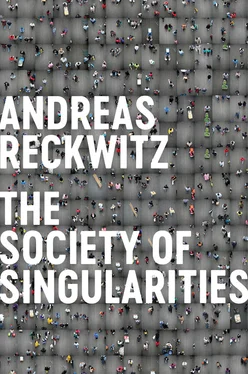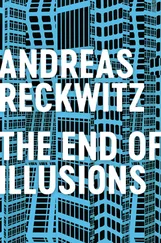In this Fordistic society, mass production was coupled with mass consumption. Instead of antagonism between the bourgeoisie and the proletariat, what appeared was the so-called “levelled middle-class society” of employees and skilled workers, who all participated in the consumption of standardized goods. This society promised a high standard of living for all. Especially during the trente glorieuses – the years 1945 to 1975 – this “affluent society” provided the imaginary backdrop of organized modernity. On the political level, this economic and technological formation was flanked by a socially regulating state, by a welfare state with a Keynesian and social-democratic or socialist plan to ensure social inclusion. The society formed along these lines was characterized by the expansive legal codification of social life and by political representation, which took place chiefly through people’s parties with their massive support and their promises to fight for the common good. 33On the spatial level, the functional city was the place where organized modernity crystallized. Both in the suburbs and in high-density public housing, the industrial city was based, as mentioned above, on functionalistic serial architecture and the spatial separation of work and domestic life. 34
Whether in the economic, technological, political, or spatial sphere, organized modernity was guided by the semantics of the social, understood as the regulated collective. 35The collectivized social – whether in the form of a crowd, group, political party, workforce, or even the nuclear family – now took on an independent and superior existence, to which the individual was subordinate. Quite fittingly, then, William Whyte and David Riesman referred to the post-bourgeois subject as an “organization man.” This was a subject who developed an extreme sensitivity to the social expectations of his peers, to which he adapted accordingly. Orienting oneself toward the social standards of normality went hand in hand with a radical disciplining of emotions. As noted above, organized modernity was essentially a society of equals, of equality before the law, and of social uniformity. This culture of equality correlated with the uniformity of subjects: individuals were compelled to shape their lives to fit a “normal biography” with clear stages and with the aim of achieving life goals. 36In Simmel’s terms, the subjects of organized modernity were thus representative of an “individualism of equality.”
All of this suggests that the social logic of the general – in the forms of standardization, generalization, and formalization, which industrial modernity enforced throughout the first two-thirds of the twentieth century – has some obvious downsides. These include social inhibition and repression on a large scale and the elimination of genuinely unique characteristics in a radical, systemic, and historically unprecedented way. These downsides affected all social entities: things, people, collectives, spaces, and times. In organized modernity, the particular or the unique was tendentially regarded as the insignificant, undesirable, or even repulsive “other” that had to be overcome (with violence, if necessary) because it did not fit into the generally valid functional order of society. Such things were treated as vestiges of the premodern, retrograde, and decadent past or – at best – as unintended and riskily peculiar marginal phenomena of modernity.
The social struggle against this “other” and against anything apparently non-rational was waged above all against ostensibly abnormal or asocial subjects, who were classified by the psycho-social complex as exhibitors of deviant behavior. 37This struggle also led to a distaste for things and objects produced outside of industrial mass production, and encouraged the neglect or destruction of local and historical spaces – and the unique culture associated with them – in favor of the functional city. With its practices, industrial modernity thus enforced the de-singularization of the social. In the practices of observation, a vast system of general concepts and scales was developed for differentiating the general-particular, and this came at the expense of a now marginalized conceptual and perceptive sensitivity to the complexity of singularities. In the practices of evaluation, the result was to discriminate against or pathologize anything that could not be made to fit into the achievement differences determined by the logic of the general. In the practices of production, unique things were either created by mistake or were relicts of premodern niche practices. In their practices of appropriation, subjects thus became successively accustomed to adopting objectifying approaches to things and in large part “unlearned,” so to speak, how to deal with singularities. 38
The rationalistic logic of the general achieved its zenith in organized, industrial modernity. It was during this time that society endeavored once and for all to triumph over the fundamental problems of scarcity and disorder mentioned above. Although many structural decisions made during this phase would remain influential in late modernity, organized modernity as an all-encompassing formation has since become history. Its social logic of the general would go on to serve as a negative example for late modernity, which would distance itself from it with its own social logic of singularities. As we will see, however, matters are somewhat more complicated. Industrial modernity was not organized in an entirely rationalistic manner, and it was not completely de-singularized. For its part, moreover, late modernity has developed its own version of rationalization, which now serves as an enabling form of infrastructure.
1 Rather than being obsolete, the theory of functional differentiation and that of capitalism are still effective for analyzing structural elements of societies that are characterized by formal rationalization. 2 See Max Weber, Economy and Society: An Outline of Interpretive Sociology, trans. Guenther Roth and Claus Wittich (Berkeley: University of California Press, 1978); and Wolfgang Schluchter, The Rise of Western Rationalism: Max Weber’s Developmental History, trans. Guenther Roth (Berkeley: University of California Press, 1981). 3 See, for instance, Georg Simmel, The Philosophy of Money: Third Enlarged Edition, trans. Tom Bottomore and David Frisby (London: Routledge, 2004); Martin Heidegger, “The Age of the World Picture,” in The Question Concerning Technology and Other Essays, trans. William Lovitt (New York: Harper & Row, 1977), pp. 115–36; Theodor W. Adorno and Max Horkheimer, Dialectic of Enlightenment, trans. John Cumming (New York: Verso, 1979); Hans Blumenberg, The Legitimacy of the Modern Age, trans. Robert M. Wallace (Cambridge, MA: MIT Press, 1983); Michel Foucault, Discipline and Punish: The Birth of the Prison, trans. Alan Sheridan (New York: Vintage, 1977); and Zygmunt Bauman, Modernity and Ambivalence (Cambridge: Polity, 1991). 4 On normality and normalism, see Jürgen Link, Versuch über den Normalismus: Wie Normalität produziert wird, 5th edn. (Göttingen: Vandenhoeck & Ruprecht, 2013). 5 See Alfred Schütz and Thomas Luckmann, The Structures of the Life-World, 2 vols., trans. Richard M. Zaner et al. (Evanston, IL: Northwestern University Press, 1973–89). 6 Similarities thus operate outside of the dualistic logic of identity and difference. See Anil Bhatti et al., “Ähnlichkeit: Ein kulturtheoretisches Paradigma,” Internationales Archiv für Sozialgeschichte der Literatur 36 (2011), pp. 261–75. 7 For such broad understanding of techne, see Hans Blumenberg, Schriften zur Technik (Berlin: Suhrkamp, 2015). On the traditional rationalization of religion and law, see the fifth and sixth chapters of Weber’s Economy and Society. 8 On the awareness of contingency, see Michael Makropoulos, Modernität und Kontingenz (Munich: Fink, 1997). 9 See also John Law, Organizing Modernity: Social Ordering and Social Theory (Oxford: Blackwell, 1994). 10 On the notion of progress, see Reinhart Koselleck, Futures Past: On the Semantics of Historical Time, trans. Keith Tribe (New York: Columbia University Press, 2004). 11 On this complex, see David F. Noble, America by Design: Science, Technology, and the Rise of Corporate Capitalism (New York: Oxford University Press, 1979); and Yehouda Shenhav, Manufacturing Rationality: The Engineering Foundations of the Managerial Revolution (Oxford University Press, 1999). 12 See H. Floris Cohen, Scientific Revolution: A Historiographical Inquiry (University of Chicago Press, 1994); and Stephen Toulmin, Cosmopolis: The Hidden Agenda of Modernity (University of Chicago Press, 1990). 13 See Link, Versuch über den Normalismus. 14 The classic treatment of this subject is Norbert Elias, The Civilizing Process: Sociogenetic and Psychogenetic Investigations, rev. edn., trans. Edmund Jephcott (Oxford: Blackwell, 2000). Regarding organized modernity, see Peter N. Stearns, American Cool: Constructing a Twentieth-Century Emotional Style (New York University Press, 1994). Of course, the reduction of affect does not mean its absence. In fact, rational complexes often have an emotional aspect, for instance the desire to create an orderly bureaucracy or the aesthetic pleasure taken in the symmetry of architecture. 15 See Geert J. Somsen, “A History of Universalism: Conceptions of the Internationality of Science from the Enlightenment to the Cold War,” Minerva 46 (2008), pp. 361–79. 16 I will keep the question open about which elements or entities in fact “assemble” the social. For further discussion of this issue, see Bruno Latour’s Reassembling the Social: An Introduction to Actor-Network-Theory (Oxford University Press, 2005). 17 See Kopytoff, “The Cultural Biography of Things.” The classical locus of criticism against the standardization of the world of objects has been the arts-and-crafts movement. 18 On both models, see Riesman, The Lonely Crowd. 19 I will treat this concept in greater detail in the next chapter. 20 This is the effect of individualization that, according to Foucault’s Discipline and Punish, characterizes disciplinary societies. Notably, Simmel associated this sort of individualism with freedom and equality; see, for instance, Georg Simmel, Sociology: Inquiries into the Construction of Social Forms, trans. Anthony J. Blasi et al. (Leiden: Brill, 2009), pp. 637–8. 21 For a clear discussion of this phenomenon in the twentieth century, see Theo Hilpert, Die funktionelle Stadt: Le Corbusiers Stadtvision – Bedingungen, Motive, Hintergründe (Braunschweig: F. Vieweg und Sohn, 1979). 22 See Marc Augé, Non-Places: Introduction to an Anthropology of Supermodernity, trans. John Howe (New York: Verso, 1995). It could be said in short that, according to the social logic of the general, all spaces are non-places. 23 See Barbara Adam, Time and Social Theory (Cambridge: Polity, 1994), pp. 123–5. 24 See Weber, Economy and Society; and Niklas Luhmann, Legitimität durch Verfahren (Frankfurt am Main: Suhrkamp, 1969). 25 See Jürgen Habermas, “Labour and Interaction: Remarks on Hegel’s Jena Philosophy of Mind,” in Theory and Practice, trans. John Viertel (London: Heinemann, 1974), pp. 142–69. 26 I refer to the first two phases of modernity as classical modernity because the social logic of the general is dominant in both of them. 27 German Idealism, within whose framework the particular can only be the general-particular, represents the high point of the philosophical foundation of the logic of the general. 28 On this phase, see also Andreas Reckwitz, Das hybride Subjekt: Eine Theorie der Subjektkulturen von der bürgerlichen Moderne zur Postmoderne (Weilerwist: Velbrück Wissenschaften, 2006), pp. 336–439; Peter Wagner, A Sociology of Modernity: Liberty and Discipline (London: Routledge, 1994), pp. 73–122; and Scott Lash and John Urry, The End of Organized Capitalism (Cambridge: Polity, 1987), pp. 17–87. Here I use the terms “organized modernity” and “industrial modernity” synonymously. 29 On the concepts of Americanism and Fordism, see Antonio Gramsci, Selections from the Prison Notebooks, trans. Quentin Hoare and Geoffrey Nowell Smith (New York: International Publishers, 1971), pp. 277–318. On the concept of organized capitalism, see Rudolf Hilferding, Organisierter Kapitalismus (Kiel, 1927). 30 See Alfred D. Chandler, The Visible Hand: The Managerial Revolution in American Business (Cambridge, MA: Belknap Press, 1977); and Maury Klein, The Flowering of the Third America: The Making of Organizational Society, 1850–1920 (Chicago, IL: Ivan R. Dee, 1993). 31 See Raymond Aron, 18 Lectures on Industrial Society, trans. M. K. Bottomore (London: Weidenfeld & Nicholson, 1967). 32 See Cecelia Tichi, Shifting Gears: Technology, Literature, Culture in Modernist America (Chapel Hill: University of North Carolina Press, 1987); and Thomas P. Hughes, American Genesis: A Century of Invention and Technological Enthusiasm, 1870–1970 (New York: Viking, 1989). 33 See John Kenneth Galbraith, The Affluent Society, 2nd edn. (London: Hamilton, 1969). Regarding the trente glorieuses, see Jean Fourastié, Les trente glorieuses, ou la révolution invisible de 1946 à 1975 (Paris: Fayard, 1979). 34 On the state, see Pierre Rosanvallon, The Society of Equals, trans. Arthur Goldhammer (Cambridge, MA: Harvard University Press, 2013). On the city, see Hilpert, Die funktionelle Stadt. 35 On my discussion below, see William Graebner, The Engineering of Consent: Democracy and Authority in Twentieth-Century America (Madison: University of Wisconsin Press, 1987); William H. Whyte, The Organization Man (New York: Simon and Schuster, 1956); and Riesman, The Lonely Crowd. 36 See Martin Kohli, “Gesellschaftszeit und Lebenszeit: Der Lebenslauf im Strukturwandel,” in Die Moderne: Kontinuitäten und Zäsuren, ed. Johannes Berger (Göttingen: Schwartz, 1986), pp. 183–204. 37 On the construction of abnormality, see Michel Foucault, Abnormal: Lectures at the Collège de France, 1974–1975, trans. Graham Burchell (New York: Verso, 2003); Howard Saul Becker, Outsiders: Studies in the Sociology of Deviance (New York: Free Press, 1963); and Bauman, Modernity and Ambivalence. 38 On the level of subjects, de-singularization is not the same thing as de-individualization. As an achievement society, organized modernity was based through and through on the post-traditional self-responsibility of subjects, which Georg Simmel referred to as the “individualism of freedom and responsibility.” Thus, it cannot be said that organized modernity was characterized by de-individualization.
Читать дальше












